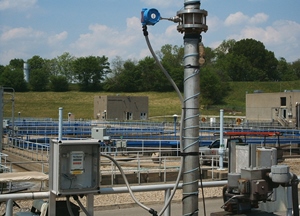



A wastewater treatment plant was trying to measure the off-gas from one of its batteries. Plant managers had previously tried a pitot tube to measure the flow. There were measurement errors due to the inability of the pitot tube to compensate for pressure and temperature changes and the port became frozen during cold weather. There was also poor turndown and insensitivity in reading lower flows.
In an attempt to correct these problems, the technicians replaced the pitot tube with a thermal dispersion flowmeter. Since flow was unknown, the factory calibrated the thermal dispersion flowmeter to read 50-500 scfm on the remote display. The installation required a bulky NEMA 4X enclosure (in the photo below). With no protection on the sensor tip of the thermal dispersion flowmeter, the tip became damaged during installation, which created measurement inaccuracies. In addition, the flowrate never went higher than 200 scfm, only allowing the new meter to read 50-200 scfm (4:1 turndown).
When they contacted the factory to have the meter re-calibrated to a more suitable range, the technicians were told there would be a 2-3 week calibration delay and an additional cost of $750 for re-calibration. The thermal dispersion flowmeter did not offer the ability for re-configuration in the field or any diagnostic troubleshooting capability on-site.
The Fox Thermal Representative for the area tested and evaluated the application with the FT2 Mass Flowmeter and Palm Pilot Kit. Within minutes of the on-site test, his demonstration unit was re-scaled from 50-500 scfm to 20-200 scfm. As a result of this test, the technicians involved with this application agreed that the accuracy at lower flow rates, the turndown capability (100:1), the compactness of the remote display (pictured as nearly ⅓ smaller than the enclosure), and the ability to re-configure the meter in the field were desirable features.
Observing the demonstration test convinced the technicians that switching out the previously purchased thermal dispersion flowmeter to the more user-friendly field instrument from Fox Thermal would help to save costly re-calibration fees. In addition, free software was included for data logging information on various scopes of performance which allowed the technicians to diagnose upset issues within their process and pinpoint finer control of the batteries’ off-gas. The performance enhanced their troubleshooting capabilities so much that they submitted the order to replace the existing thermal dispersion flowmeter with an Fox Thermal Mass Flowmeter and an additional application that was awarded within the next few months.